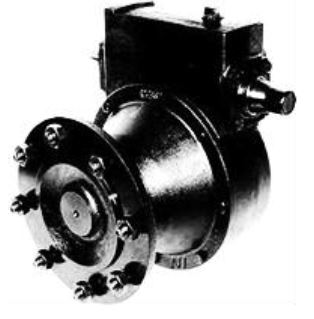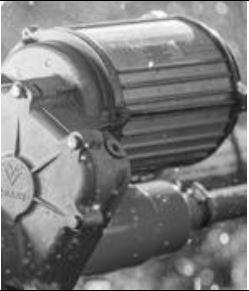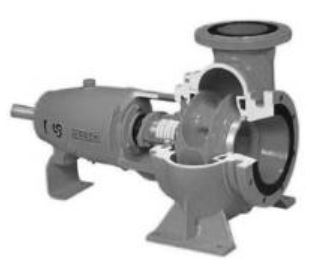AGRICULTURAL TECHNOLOGY GRADE 12 MEMORANDUM - NSC PAST PAPERS AND MEMOS NOVEMBER 2021
Share via Whatsapp Join our WhatsApp Group Join our Telegram GroupAGRICULTURAL TECHNOLOGY
GRADE 12
NSC EXAMINATIONS
NOVEMBER 2021
MEMORANDUM
SECTION A
QUESTION 1
1.1
1.1.1 C
1.1.2 D
1.1.3 B
1.1.4 C
1.1.5 A
1.1.6 D
1.1.7 A
1.1.8 D
1.1.9 C
1.1.10 A
1.2
1.2.1 Yield monitor/Monitor/Harvest Monitor
1.2.2 Nickel
1.2.3 Tension/Density
1.2.4 Hydraulic oil
1.2.5 Carbon monoxide
1.3
1.3.1 B
1.3.2 A
1.3.3 G
1.3.4 D
1.3.5 E
SECTION B
QUESTION 2: MATERIALS AND STRUCTURES
2.1 The metal that can be used to manufacture a coiled spring
- Medium carbon steel
- Spring steel
- Bronze
2.2 THREE properties of Vesconite that makes it possible for use in marine applications.
- Vesconite gives long life with low maintenance and low friction.
- Water is an excellent lubricant for Vesconite.
- No lubricant needed
- Vesconite will not swell and seize or soften when subjected to wet conditions.
- Vesconite is dimensionally stable.
- Is corrosion resistant.
- It remains hard in water.
- It does not delaminate/crumble
- Easy to machine.
- Waterproof/resistant.
- Does not react with chemicals.
(Any 3) (3)
2.3
2.3.1 THREE commercial uses of Teflon.
- All-weather clothing.
- Eyeglass lens coating.
- Teflon tape.
- Magazines for guns.
- Coating for cookware.
- Oil and water seals.
- O-rings.
- Pipe saddles.
- Valves.
- Flanges.
- Wiper blades.
- Lubrication.
- Solar panel surface coating.
(Any 3) (3)
2.3.2 The critical melting point of Teflon.
- Plus minus 327 °C.
- The point where the Teflon will start melting.
(Any 1) (1)
2.4 FOUR properties of copper that make it ideal for the manufacturing of electrical wires.
- Copper is a good conductor of heat.
- Copper is a good conductor of electricity.
- Does not rust/ corrode easily.
- It is ductile./Malleable
- Can be easily joined by soldering.
- Durability/Lasts long.
- It is flexible.
- Can be manufactured into a variety of diameters and lengths.
- Non-magnetic.
(Any 4) (4)
2.5 FOUR properties of brass products that makes it more suitable than the use of steel products.
- Resists metal fatigue better than steel.
- Better conductor of heat and electricity than most steels.
- High electrical conductivity.
- Low-friction properties of bearing bronze.
- Resonant qualities of bell bronze.
- Resistance to corrosion/rust by sea water.
- Durable.
- Shining.
(Any 4) (4)
2.6 TWO circumstances where bronze hammers are used instead of metal hammers.
- In explosive atmospheres.
- In the presence of flammable vapours.
- To prevent dents on metal Bearings.
(Any 2) (2)
2.7 Complete the following table by writing only the correct answer in your answer book next to the appropriate question number.
| Type of adhesive | Use of product |
| Silicon | 2.7.1 Sealant/joining. |
| PVC Weld | 2.7.2 Joining PVC pipes/products. |
| Resorcinol | 2.7.3 Joining or sealing of wood products. |
| No more nails | 2.7.4 Mounting applications |
(4)
2.8
2.8.1 Description of the 'resin' that is used in the making of glass fibre products.
- A low viscosity fluid or paste that can be transformed to tough flexible solids by adding a hardening agent. (2)
2.8.2 THREE reasons why glass fibre is preferred as a construction material for the manufacturing of small boats.
- Lightness.
- Easily repaired when broken.
- Strength / toughness
- Stability.
- Water tight.
- Easy to colour.
- Easy to shape.
- Easy to clean.
- Corrosion resistant.
- Not conducting electricity.
(Any 3) (3)
2.9
2.9.1 Description of the working of the earth return system of an electric fence.
- As with all energizers there must be a return path through the ground and earth spike back to the energizer in order to complete the loop.
- The animal is the missing link that complete the loop.
- If the animal touches the wire an electric current, spark or shock passes from the wire through the animals back to the energiser.
(Any 2) (2)
2.9.2 TWO probable causes of a voltage drop in the electric fence circuit.
- Vegetation touching the electric fence wires.
- Short circuit,
- defective energizer,
- cracked isolators,
- wires touching the ground.
(Any 2) (2)
2.9.3 The procedure that must be followed when testing the earth system of an electric fence.
- First short out the live fence line to the ground, either with a metal stake or by laying the fence line on the ground for about 100 meters and at least 30 meters away from the energizer.
- Switch the energizer ON.
- Measure the voltage between the ground and the earth spike with a multi-meter. If this is above 200 volts the earth installation is inefficient.
- Check the connections or increase the number of earth spikes.
- If you get a shock from the earth spike before you short the fence line then there is a poor earth and possibly a fault on the fence line as well.
(Any 4) (4) [35]
QUESTION 3: ENERGY
3.1
3.1.1
The source of the energy shown in the illustration.
- Geothermal energy.
(1)
3.1.2 THREE important factors that can play a role in the initial exploration phase of the energy source.
- Is the rock formation suitable to drill through?
- Do the source contain sufficient heat?
- Sustainability of the heat source.
- Environmental factors.
- Local community/ green groups don't support the installation.
(Any 3) (3)
3.2
3.2.1 Description of the process of generating electricity with a wind turbine.
- The wind turns aeroplane shaped blades that are attached to the turbine.
- The turbine turns the main shaft.
- This turning motion is transferred by the shaft to the gearbox.
- The gearbox increases the revolutions.
- The gearbox output shaft is connected to the generator that produces electricity.
(Any 4) (4)
3.2.2 Necessity of adjusting the pitch of the blades of a wind turbine.
- Increase or decrease the rotating speed.
(1)
3.2.3 The necessity to change the pitch of the blades on a regular basis.
- Protect the wind turbine from turning too fast in strong winds and too slow in mild winds.
- To harness the full power of the available wind.
(Any 2) (2)
3.2.4 THREE disadvantages of wind energy.
- Unreliability of the wind in certain areas.
- Wind turbines produce a lot less electricity than other available resources.
- Construction of wind turbines can be very costly.
- High noise levels.
- Can take time to repair if parts are defective.
- Can affect ecosystem (animal movement and behaviour)
(Any 3) (3)
3.3 FOUR reasons why photovoltaic energy panel systems are suitable for use in deep rural areas where electricity is not available.
- No power lines needed.
- No noise from generators.
- Energy cheap after initial installation.
- No pollution.
- It is portable.
- Easy to install.
- Easy to maintain.
- More reliable energy source.
- Can store energy in batteries for use at night.
- No Carbon taxes.
- No fuel costs.
- Renewable source of energy.
- Sufficient amount of energy.
(Any 4) (4)
3.4 TWO types of plants that can be used as a source to manufacture biodiesel.
- Sunflower.
- Soya.
- Canola.
- Sugarcane.
- Maize.
- Sorghum.
- Wheat (Mark any oily plant correct)
(Any 2) (2)
[20]
QUESTION 4: SKILLS AND CONSTRUCTION PROCESSES
4.1
4.1.1 Identification of parts A and B as indicated in the illustration.
- Welding gun.
- Crocodile clamp/Earth clamp/Earth connection. (2)
4.1.2 TWO gases provided as a mixture by the cylinder.
- Argon ,CO2. and Helium.
(Any 2) (2)
4.1.3 The function of the heat that is produced by the electric arc.
- Melts the metal to produce the joint.
(1)
4.1.4 The purpose of the gas shielding the welding bead.
- Shields the area around the welding process so that the melted metal joint does not get contaminated by surrounding air/oxygen.
(2)
4.1.5 TWO non-ferrous metals that can be successfully welded with this machine.
- Copper.
- Aluminium.
- Titanium.
(2)
4.2 The function of a Push Pull torch as found on a MIG – welding machine.
- This is a MIG torch used for aluminium welding. The torch head has a pair of rollers driven by a motor which pulls the wire as well as the MIG welder roller system pushing the wire. This ensures correct wire feed of the softer alloy wire and prevents snags and wire feed problems.
(Any 2) (2)
4.3 The precautionary measures that can be taken to overcome the problem of dripping metal when welding in the vertical up welding position.
- A special electrode can be used.
- The tip of the electrode must be pointed upwards so that it forms an angle up to 30 with the horizontal plane.
- Arc must be kept short.
- Speed must be sufficient.
- Very little lateral movements of the electrode must be made.
(5)
4.4
4.4.1
Calculation of the total cost for the materials needed if two hinges cost R24.00 and 1 meter of 25mm round tubing costs R11.40.
Show all calculations.
- Round tubing:
(700 mm x 8) + (600 mm x 4).
= 8 000 mm.
OR
= 5 600 mm + 2 400 mm.
= 8 000 mm.
8 m x R11,40.
= R91,20.
Total cost: R91,20 + R24,00.
= R115,20.
(6)
4.4.2 The total area of one gate.
- Area = length x breadth
= 600 mm x 700 mm.
= 4 20 000 mm2.
Or
0.42 m2
(2)
4.4.3 THREE types of pipe welding positions.
- Horizontal fixed position.
- Vertical position.
- Vertical/Horizontal movable position.
(3)
4.5 Description of 'hard-facing' as done on the front end of the ripper tooth.
- It is the process by means of which worn parts can be built up by padding with a wear resistant metal.
- The type of hard-facing and type of electrode used are determined by the service requirements of the parts concerned. (Any 2)
(2)
4.6 TWO reasons for the distortion of metal plates that can occur in welding joints.
- Too much heat.
- Wrong welding technique.
- Wrong setup/pre-setting.
(2)
4.7 Comparison of the plasma cutting process to the Oxy-acetylene cutting process by completing the table.
| Plasma cutting | Oxy-acetylene cutting | |
| Speed | 4.7.1 High cutting speed. | 4.7.2 Low cutting speed. |
| Gasses used | 4.7.3 Argon. Nitrogen. Oxygen. (Any 1) | |
| Radiation | 4.7.4 Low. |
(4)
[35]
QUESTION 5: TOOLS, IMPLEMENTS AND EQUIPMENT
5.1
5.1.1 Explanation of what is meant with 'timing' of the ram baler.
- It is the exact moment when the needles lift the binding rope to bound the compressed hay.
(2)
5.1.2 THREE requirements for the screens used to safeguard the dangerous mechanisms of implements.
- Must appear neat.
- Safeguard the equipment.
- Removed and replaced easily.
- Don't become loose.
- Weight saving.
- Keep out all undesired matter.
- Must be strong.
- Warning signs.
(Any 3) (3)
5.1.3 FOUR safety mechanisms that could be found on the ram-type bailing machine.
- Slip clutch.
- Screens/covers.
- Shear bolt.
- Ram stop safety mechanism.
(4)
5.2 FOUR safety precautions when working with the combine harvesting machine.
- Don't let people ride on top of the harvester.
- Watch out for obstacles in the way of the harvester.
- Drive mechanisms must be screened off.
- Operate according to circumstances/instruction manual.
- Re-position the grain delivery auger after emptying the grain bin.
- Take note and act on warning signals from sensors.
- Fix mechanical problems immediately.
- Check for mechanical problems.
- Keep clothing away from moving parts.
- Switch off the machine when doing maintenance.
(Any 4) (4)
5.3
5.3.1 Identification of the gear.
- Double-helical gear. (Herringbone gear).
(1)
5.3.2 ONE disadvantage of this type of gear.
- Cannot be used in gearboxes of cars because it cannot be meshed from the side. (Any 1)
(1)
5.4
5.4.1 FOUR factors that must be considered when a new hammer mill is bought.
- Must have a sturdy construction.
- Replaceable wearing parts.
- Rotor housing should close tightly.
- Size of the hopper feed aperture/opening.
- Availability of parts.
- Service intervals.
(Any 4) (4)
5.4.2 THREE advantages of installing a hammer mill on a level surface.
- The mass of moving parts is spread equally over bearings.
- Cyclone hangs level on the blower pipe.
- Looks neat.
- Minimum vibration.
- Prevent damage to parts.
- Prevent from falling over.
(Any 3) (3)
5.4.3 THREE factors to be considered when attaching the hammer mill to the PTO shaft of the tractor.
- Check if the anchor bolts of the static machine are tight.
- Check that the universal joints are well lubricated.
- Check that the drive shaft guard is present and without cracks.
- Check that the driving shaft is properly secured to the PTO shaft.
- Ensure that the driving shaft is as straight as possible.
- Check for bystanders when reversing the tractor.
- Make sure that the hammer mill is level.
(Any 3) (3)
5.5
5.5.1 TWO advantages of using this mechanism to move heavy hay bales.
- The rear tyres of a tractor are better suited to carry the extra weight.
- There is less chance of side overturns.
- The load is not too high.
(Any 2) (2)
5.5.2 THREE components on a tractor's three-point mechanism that are used to connect this implement.
- Two lifting arms.
- Top link.
- Two stabilising chains or arms.
(3)
5.6 Description of the working of an automatic depth control mechanism as found on a tractor.
- The automatic depth control mechanism is activated by the sensitivity element when the ploughing depth changes according to ploughing circumstances.
- Ploughing depth varies when the plough penetrates too deeply in soft patches of soil or when the plough tends to lift up in a hard patch of soil.
(4)
5.7
5.7.1 The necessity to install bearings in the drive mechanisms of pumps.
- To reduce wear of moving parts.
- To avoid overheating of parts.
- To facilitate extended use of parts at high speed.
- To avoid premature of failure of parts.
(Any 2) (2)
5.7.2 ONE task that should be performed during the maintenance of this type of bearing.
- Apply appropriate lubricant.
- Cleaning.
- Check if seals are intact and not worn/broken.
- Check minimum free play.
(Any 1) (1)
5.8 THREE types of gearboxes that can be used in tractors.
- Sliding gearbox.
- Constant mesh gearbox.
- Synchronised gearbox.
- Automatic gearbox.
(3)
[40]
QUESTION 6: WATER MANAGEMENT
6.1 Names of the different components and one function of each.
| Name of component | Function of component | |
 | 6.1.1 Gearbox. | 6.1.2 Provides rotation to the wheels and also reduce the speed to the wheels. |
 | 6.1.3 Electric motor. | 6.1.4 Turns the gearbox connected to the wheels. |
 | 6.1.5 Water pump/Centrifugal pump. | 6.1.6 Delivers the water from the source to the centre pivot. |
(6)
6.2
6.2.1 How a drone can help a farmer to increase crop yield on a piece of irrigation land.
- By installing a multispectral camera on the Drone.
- The camera can detect moisture variances in soil and generate a geographic map.
- It detects system faults. Leaking pipes or tyres that are deflated.
- It can detect persons that steal or vandalise equipment.
- It can detect areas where plant growth is weak. (Any 3)
(3)
6.2.2 The system installed on the Drone to pin point exact location.
- GPS (Global Positioning System).
(1)
6.3 THREE types of sensors that provides input data to the 'irrigation controller' of an irrigation system.
- Soil moisture sensor.
- Rain sensor/Rain meter
- Humidity sensor.
- Wind speed sensor.
- Tensiometer.
- Barometer/pressure meter.
- VRT/GPS (Any 3)
(3)
6.4 This can be installed on the water delivery pipe of an irrigation system to measure the exact amount of water that is delivered to the crop.
- Water meter/Flow meter. (1)
6.5 Importance of automation of an irrigation system.
- To save water.
- Prevent over irrigation.
- Prevent under irrigation.
- To save money.
- Optimisation of labour.
- Distance control/monitoring.
(Any 4) (4)
6.6 Description of the working of a farmhouse septic tank system from the moment that waste has been flushed down the toilet.
- Sewage enters the septic tank through the inlet pipe.
- Heavy solids settle to the bottom.
- The lighter solids, fats and greases partially decompose and rise to the surface and form a layer of scum.
- The solids that have settled to the bottom are broken down by bacteria and form sludge.
- The discharge from the septic tank is distributed evenly to the absorption field.
(5)
6.7 TWO common materials used to manufacture the rainwater gutters and down pipes found on farm buildings.
- Aluminium.
- PVC.
- Zinc.
- Galvanized steel.
(Any 2) (2)
6.8 Description of the distillation process used to purify battery water.
- Water is boiled until it turns into steam/vapour.
- The steam/vapour is transferred to a different container via a piping system.
- Cooled down steam turns back into distilled water.
(3)
6.9 Complete the following table by writing the correct answer next to the appropriate question number.
| Technological System | Application |
| Geographical Information System | 6.9.1 Can be used to monitor plant growth/density. |
| Variable Rate Technology | 6.9.2 Found in field equipment and has the ability to precisely control application rate of fertilisers/ manure/pesticides/herbicides/irrigation . |
(2)
[30]
TOTAL SECTION B: [160]
GRAND TOTAL: [200]